Themed collection Most popular 2018-2019 chemical biology articles

Asking more from metabolic oligosaccharide engineering
Metabolic Oligosaccharide Engineering (MOE) is a groundbreaking strategy which has been largely used in the last decades, as a powerful strategy for glycans understanding. The present review aims to highlight recent studies that are pushing the boundaries of MOE applications.
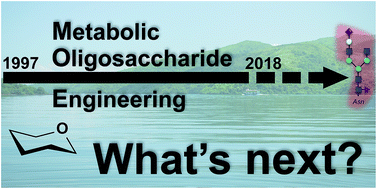
Chem. Sci., 2018,9, 7585-7595
https://doi.org/10.1039/C8SC02241K
Tuning protein folding in lysosomal storage diseases: the chemistry behind pharmacological chaperones
We review pharmacological chaperones used in lysosomal storage diseases, emphasizing medicinal chemistry approaches and mechanisms of action.
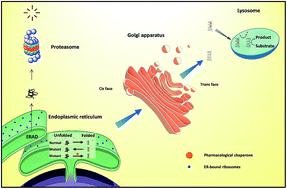
Chem. Sci., 2018,9, 1740-1752
https://doi.org/10.1039/C7SC04712F
Biomedical applications of copper-free click chemistry: in vitro, in vivo, and ex vivo
Copper-free click chemistry has resulted in a change of paradigm, showing that artificial chemical reactions can occur on cell surfaces, in cell cytosol, or within the body. It has emerged as a valuable tool in biomedical fields.
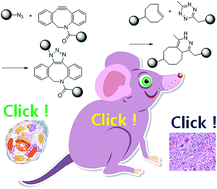
Chem. Sci., 2019,10, 7835-7851
https://doi.org/10.1039/C9SC03368H
Mechanisms of catalytic reduction of CO2 with heme and nonheme metal complexes
This critical review discusses the thermal and photocatalytic mechanisms of one-, two-, four-, six- and eight-electron reduction of CO2 with metal complex catalysts.
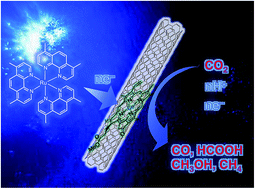
Chem. Sci., 2018,9, 6017-6034
https://doi.org/10.1039/C8SC02220H
Advances in targeting the folate receptor in the treatment/imaging of cancers
The folate receptor (FR) is an important biomarker for many cancers, and its overexpression on tumours can be exploited for targeted therapy, diagnosis and imaging.
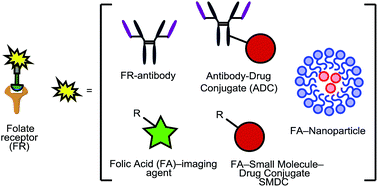
Chem. Sci., 2018,9, 790-810
https://doi.org/10.1039/C7SC04004K
A photochromic upconversion nanoarchitecture: towards activatable bioimaging and dual NIR light-programmed singlet oxygen generation
A novel upconversion nanoarchitecture is designed, whose 980 nm light photosensitized activity could be activated by 808 nm light.
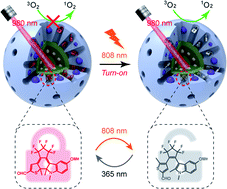
Chem. Sci., 2019,10, 10231-10239
https://doi.org/10.1039/C9SC03524A
Self-triggered click reaction in an Alzheimer's disease model: in situ bifunctional drug synthesis catalyzed by neurotoxic copper accumulated in amyloid-β plaques
Accumulated Cu in amyloid-β plaques can effectively catalyze the azide–alkyne cycloaddition reaction for fluorophore activation and drug synthesis. Our work may provide new insight into in situ drug synthesis for neurodegenerative diseases.
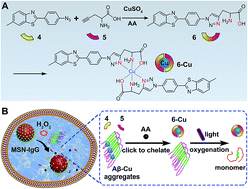
Chem. Sci., 2019,10, 10343-10350
https://doi.org/10.1039/C9SC04387J
Isomeric triazines exhibit unique profiles of bioorthogonal reactivity
Isomeric triazines can be tuned to exhibit unique reaction profiles with biocompatible strained alkenes and alkynes.

Chem. Sci., 2019,10, 9109-9114
https://doi.org/10.1039/C9SC01427F
Designer artificial membrane binding proteins to direct stem cells to the myocardium
We present a new cell membrane modification methodology where the inherent heart tissue homing properties of the infectious bacteria Streptococcus gordonii are transferred to human stem cells.
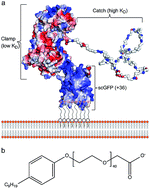
Chem. Sci., 2019,10, 7610-7618
https://doi.org/10.1039/C9SC02650A
RGD conjugated cell uptake off to on responsive NIR-AZA fluorophores: applications toward intraoperative fluorescence guided surgery
The tumour switches on the NIR-AZA emission for fluorescence guided surgery.
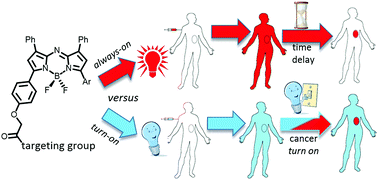
Chem. Sci., 2019,10, 6944-6956
https://doi.org/10.1039/C9SC02197C
A nano-cocktail of an NIR-II emissive fluorophore and organoplatinum(II) metallacycle for efficient cancer imaging and therapy
A novel NIR-II theranostic nanoprobe, PSY (∼110 nm), was concisely developed, which demonstrated excellent photostability, high tumor uptake, superior S/N ratios and more efficient cancer treatment with minimal side effects than cisplatin.
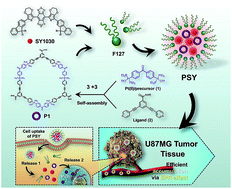
Chem. Sci., 2019,10, 7023-7028
https://doi.org/10.1039/C9SC02466B
Photoactivated cell-killing involving a low molecular weight, donor–acceptor diphenylacetylene
Drug-like, donor–acceptor diphenylacetylenes cause efficient cell death upon photoactivation and hence have potential phototherapeutic applications.
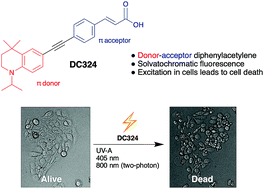
Chem. Sci., 2019,10, 4673-4683
https://doi.org/10.1039/C9SC00199A
Hollow nanoreactors for Pd-catalyzed Suzuki–Miyaura coupling and O-propargyl cleavage reactions in bio-relevant aqueous media
We describe the fabrication of hollow microspheres consisting of mesoporous silica nanoshells decorated with an inner layer of palladium nanoparticles and their use as Pd-nanoreactors in aqueous media.
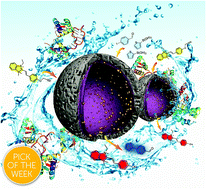
Chem. Sci., 2019,10, 2598-2603
https://doi.org/10.1039/C8SC04390F
Simultaneous dual-colour tracking lipid droplets and lysosomes dynamics using a fluorescent probe
NIM-7 is demonstrated to be a multicomponent fluorescent probe that accumulates in both lipid droplets and lysosomes after entering cells, giving rise to yellow and red fluorescence emission, respectively. This allows the two organelles to be visualized concurrently.
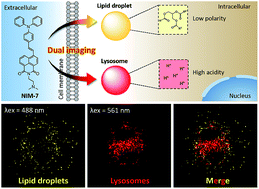
Chem. Sci., 2019,10, 2342-2348
https://doi.org/10.1039/C8SC04462G
Dual-biomarker-triggered fluorescence probes for differentiating cancer cells and revealing synergistic antioxidant effects under oxidative stress
Dual-biomarker-triggered fluorescent probes were developed for simultaneous detection of the two biomarkers H2S and hNQO1 in cancer cells.
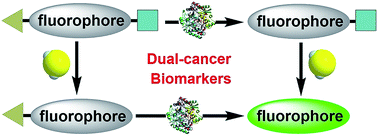
Chem. Sci., 2019,10, 1945-1952
https://doi.org/10.1039/C8SC03781G
Fluorogenic hydrogen sulfide (H2S) donors based on sulfenyl thiocarbonates enable H2S tracking and quantification
Hydrogen sulfide (H2S) is an important cellular signaling molecule that exhibits promising protective effects.

Chem. Sci., 2019,10, 1873-1878
https://doi.org/10.1039/C8SC05200J
Selective C–H halogenation over hydroxylation by non-heme iron(IV)-oxo
Synthetic non-heme iron-oxo and iron-halide complexes promote selective halogenation of the sp3-C–H bonds via hydrogen atom abstraction and halide rebound phenomenon.
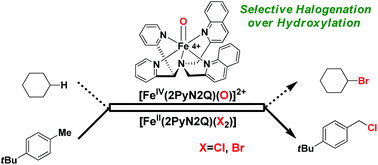
Chem. Sci., 2018,9, 7843-7858
https://doi.org/10.1039/C8SC02053A
ZrMOF nanoparticles as quenchers to conjugate DNA aptamers for target-induced bioimaging and photodynamic therapy
Aptamer conjugated porphyrinic metal–organic framework (MOF) achieved target-induced bioimaging and photodynamic therapy.
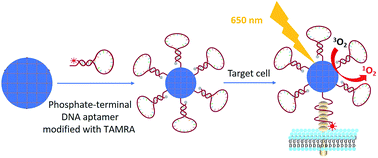
Chem. Sci., 2018,9, 7505-7509
https://doi.org/10.1039/C8SC02210K
Visualization of methylglyoxal in living cells and diabetic mice model with a 1,8-naphthalimide-based two-photon fluorescent probe
A 1,8-naphthalimide-based two-photon fluorescent probe was designed to visualize MGO levels in living cells and a diabetic mice model.
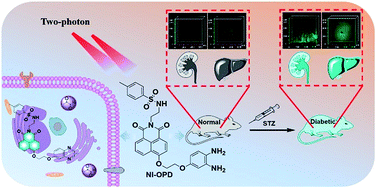
Chem. Sci., 2018,9, 6758-6764
https://doi.org/10.1039/C8SC02578A
Self-resistance guided genome mining uncovers new topoisomerase inhibitors from myxobacteria
Mining the genome to harvest from the metabolome: a well-directed search for bioactive natural products unearths the pyxidicyclines from Pyxidicoccus.
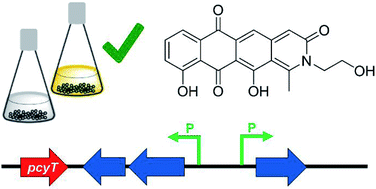
Chem. Sci., 2018,9, 4898-4908
https://doi.org/10.1039/C8SC01325J
Triple action Pt(IV) derivatives of cisplatin: a new class of potent anticancer agents that overcome resistance
A series of triple action Pt(IV) prodrugs was designed to test the hypothesis that multi-action compounds, where each bioactive moiety intervenes in several cellular processes, might be more effective than a single agent at killing cancer cells.
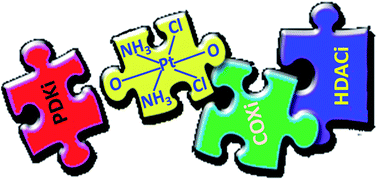
Chem. Sci., 2018,9, 4299-4307
https://doi.org/10.1039/C8SC00428E
A thioether-directed palladium-cleavable linker for targeted bioorthogonal drug decaging
We describe the development of a bifunctional linker that simultaneously allows site-specific protein modification and palladium-mediated bioorthogonal decaging.
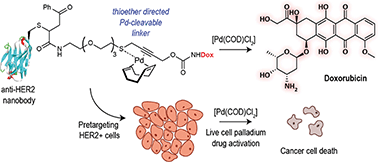
Chem. Sci., 2018,9, 4185-4189
https://doi.org/10.1039/C8SC00256H
Highly luminescent, biocompatible ytterbium(III) complexes as near-infrared fluorophores for living cell imaging
We report three synthetic methods to prepare biocompatible Yb3+ complexes, which displayed high NIR luminescence with quantum yields up to 13% in aqueous media. This renders β-fluorinated Yb3+ porphyrinoids a new class of NIR probes for living cell imaging including time-resolved fluorescence lifetime imaging.
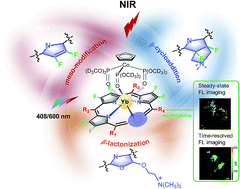
Chem. Sci., 2018,9, 3742-3753
https://doi.org/10.1039/C8SC00259B
Fluorescent dyes and probes for super-resolution microscopy of microtubules and tracheoles in living cells and tissues
Nanoscopy compatible fluorescent tubulin probes can be used to stain microtubules and chitin-rich taenidia in the insect tracheoles.
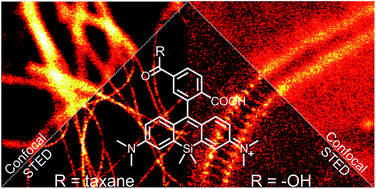
Chem. Sci., 2018,9, 3324-3334
https://doi.org/10.1039/C7SC05334G
A mitochondria-targeted nanoradiosensitizer activating reactive oxygen species burst for enhanced radiation therapy
We developed a novel strategy for enhanced radiation therapy based on a mitochondria targeted titanium dioxide-gold nanoradiosensitizer.
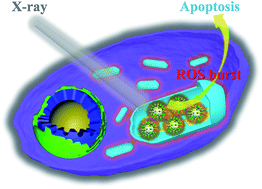
Chem. Sci., 2018,9, 3159-3164
https://doi.org/10.1039/C7SC04458E
Multicolor monitoring of cellular organelles by single wavelength excitation to visualize the mitophagy process
Two AIEgens are designed for tracking mitochondria and lysosomes with different emission colors using single wavelength excitation to visualize the mitophagy process.
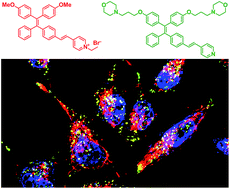
Chem. Sci., 2018,9, 2756-2761
https://doi.org/10.1039/C7SC04585A
A chemiluminescent probe for cellular peroxynitrite using a self-immolative oxidative decarbonylation reaction
Peroxynitrite is a damaging agent of oxidative stress that has been difficult to monitor in living cells. Here, an isatin-based chemiluminescent probe for peroxynitrite is reported.
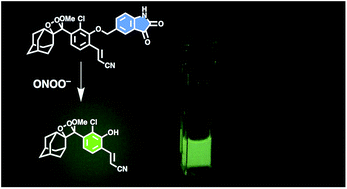
Chem. Sci., 2018,9, 2552-2558
https://doi.org/10.1039/C7SC05087A
Peptide nucleic acid-templated selenocystine–selenoester ligation enables rapid miRNA detection
A PNA-templated peptide ligation reaction has been developed between selenocystine and selenoesters. The methodology was used for the sequence specific detection of miRNA at low concentrations.

Chem. Sci., 2018,9, 896-903
https://doi.org/10.1039/C7SC02736B
Unequivocal determination of caulamidines A and B: application and validation of new tools in the structure elucidation tool box
Newly described NMR experimental approaches can provide valuable structural details and a complementary means of structure verification.
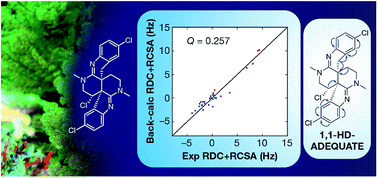
Chem. Sci., 2018,9, 307-314
https://doi.org/10.1039/C7SC01996C
Forming next-generation antibody–nanoparticle conjugates through the oriented installation of non-engineered antibody fragments
Enabling oriented installation of non-engineered antibody fragments on nanoparticle surfaces to create next-generation antibody–nanoparticle conjugates.

Chem. Sci., 2018,9, 79-87
https://doi.org/10.1039/C7SC02747H
About this collection
This specially curated collection pulls together some of the most popular articles from 2018 and 2019 in the field of chemical biology. The collection presents some outstanding contributions to the field, ranging from dual-biomarker-triggered fluorescence probes for differentiating cancer cells to a review of the biomedical applications of copper-free click chemistry, and as with all Chemical Science articles - they are all completely free to access and read. We hope you enjoy browsing through this collection.
See also: